The Ultimate Guide to Content Marketing in 2022
When you hear the word content marketing, what pops in your mind?
Blogs? SEO? Website copy? Viral social media content?
Content marketing is a lot more than that and has been around forever. At least ever since people started telling stories.
According to Content Marketing Institute (one of the top places to learn about content marketing), the very first occurence of content marketing was over 300 years ago in 1732.

Content marketing has evolved and grown quite a bit in that past couple of decades.
What is content marketing?
According to the Content Marketing Institute, “Content marketing is the marketing and business process for creating and distributing relevant and valuable content to attract, acquire, and engage a clearly defined and understood target audience – with the objective of driving profitable customer action.”
Brafton describes content marketing as, “the creation and distribution of digital marketing collateral with the goal of increasing brand awareness, improving search engine rankings and generating audience interest.”
In simpler terms, what exactly is content marketing?
Content marketing is creating and sharing content that not only appeals to your target audience but also helps you meet your marketing goals.
For example, if your goal is to increase brand reach, you might create social media content. So anything from potential-to-go-viral videos to informative and educational posts on social media.
School Year Abroad (SYA) used social media content marketing to increase their brand reach and drive traffic to their website.
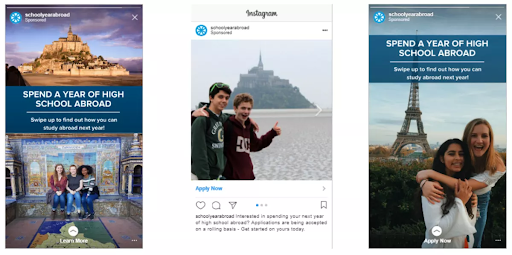
And did they accomplish their goal? Absolutely!
In under a year they, social became their highest website traffic generator.
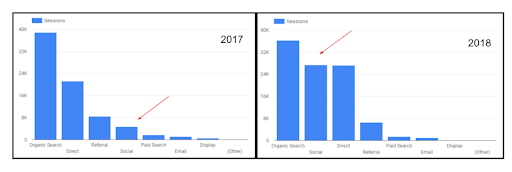
If your goal is to convert cold audiences into hot, ready-to-buy leads, you might want to create product review and testimonial videos and share them with your audience. Upselling and cross selling emails are also excellent at prompting warmer leads into converting.
Argos, for example, bolstered their conversions by sending this simple follow up email to their window shoppers.
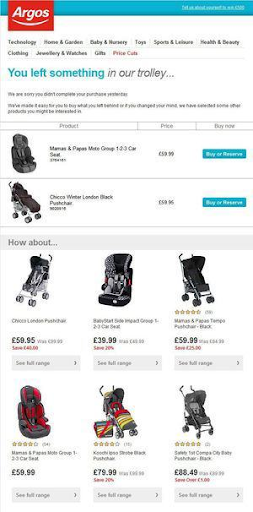
Similarly, if you’re trying to create brand awareness and establish your authority in the industry, blog posts work great.
This is the power of content marketing. If done right, it can reap benefits beyond your wildest imagination.
Why do businesses need to invest in content marketing?
If you’ve been part of the digital world for some time now, you’ve probably heard the phrase ‘Çontent is the king’. But why is that? Why is content considered the king of all digital marketing activities?
Because content is the bridge between your brand (your products and services) and your customers.
So do you need to invest in content marketing?
Absolutely.
Here’s why.
- Visibility
When you’re trying to increase your brand reach, make your brand more discoverable, and generally get some traction online, you need content. Content marketing helps to increase your brand awareness and get you visibility in front of a brand new audience.
According to the Content Marketing Institute, 86% of B2B marketers have used content marketing in the year to raise brand awareness.
For example, if you’re a newly launched brand in the beauty niche, creating viral beauty hacks and tutorial videos (and distributing them via organic and paid channels) will ensure that your brand comes in front of an audience that likes to consume this type of content. With time, you’ll start attracting more and more people towards your content and your reach will increase.
- Deeper relationships
Digital marketing is all about cultivating relationships with your target audience. Especially when you’re just starting out and targeting top of the sales funnel prospects.
Creating the right kind of content makes it very easy to build relationships.
Let’s take social media content, for example. Asking the right questions in your content captions will encourage your audience to engage with you. Similarly, creating social media and blog content that solves their problems will also prompt your audience into engaging with your content.
This ultimately builds trust and turns mere prospects into loyal cheerleaders.
- Helps control the narrative
Want to be known as the expert in your niche?
Want to be known as the fun-est, most relatable brand in the B2B niche?
Whatever narrative you’re aiming for, you can create it via content.
For example, Warby Parker’s brand identity screams fun and they promote this brand image via quirky content.
Embed: https://youtu.be/UhimXYM_J8k
- Generates referrals
How difficult is it to get people to share your brand? Very. Especially if they’re new.
But if someone likes your content – an informational video, a fun meme, or even an educational blog post – and decides to share it in their circle, that’s a free referral!
- Improves SEO
You’ve probably heard all about search engine optimization. Google is the biggest and most popular search engine and everyone goes on Google to search for their queries. Afterall, in 2021 (to date), Google accounted for just over 70% of all global desktop search traffic, followed by Baidu at 13%, Bing at 12%, and Yahoo at 2%.
So if you want Google to present your website (and your blog post) as the answer to their search queries, you need to create search engine optimized content.
Investing in content marketing is key for popping up on the first page of Google for search queries in your niche. Research shows that the first organic result in Google Search has an average click-through rate of 28.5%.
- More website traffic and leads
You want to drive traffic to your website right? Convert prospects into leads?
Content marketing helps you accomplish that goal very easily.
Long form blog content is an excellent way of driving people to your website, and adding content upgrades help to convert that traffic.
There’s a reason why 60% of marketers create at least one piece of content each day.
- Helps to build a valuable digital asset
Evergreen content – one that doesn’t get old with time but continues to reap rewards – is a very valuable digital asset in today’s time and age. With a few tweaks and a little updating, long form blog content continues to pay off year after year. Its ROI also increases over time and it helps to build brand authority in the niche as well.
12 types of content to include in your content marketing plan
To create a content strategy, you need to know the different types of content you can create. You don’t have to create all of them at once, but knowing all of them will help you decide which ones work best for your goals and audience.
Blog posts
Let’s start with the most basic, the quintessential blog post. Even within blog posts there are different types of content you can create.
- Informational blog posts
- Listicles
- Guest blogs
- Articles, akin to newspaper articles
- Long form guides
- Round ups
- Predictions
- Failures
- Best practices
- Opinions
- Product reviews
- Shorter 500 word blog posts answering a specific query
- Newsletters
- White-papers
- Ebooks
- Company news
- Product announcements
Website
Website content is another area where businesses need to focus on. A highly optimized website can make or break your digital business.
Some website pages that come under content marketing and copywriting include,
- Feature pages
- Comparison pages
- Landing pages
- News releases
Podcasts
Did you know,
- 55% of Americans have listened to a podcast.
- One-third of millennials regularly listen to podcasts.
- 54% of podcast consumers say that they are more likely to consider the brands they hear advertised on podcasts.
Audio content is on a rise and marketers are quick to understand this. More and more marketers and brands are investing in audio content – mainly in the form of podcasts.
One of the oldest forms of content marketing, emails are still very much relevant today.
Interactive content
Ever participated in an online quiz? Or came across one while scrolling through Facebook?
Interactive content is an excellent way to encourage user participation. According to research, 93% of marketers agree that interactive content is effective in educating buyers versus just 70% for static content.
Interactive content includes,
- Calculators
- Branded games
- Quizzes
- Questionnaires
- Interactive infographics
- Surveys and polls (especially ones you can create on social media – for example, Instagram and Facebook stories, LinkedIn polls, etc.)
- Interactive emails
Video
As cliche as that sounds, video truly is the future. Just a couple of days back Mark Zuckerberg announced,
Embed: <iframe src=”https://www.facebook.com/plugins/post.php?href=https%3A%2F%2Fwww.facebook.com%2Fzuck%2Fposts%2F10114335272495801&show_text=true&width=500″ width=”500″ height=”228″ style=”border:none;overflow:hidden” scrolling=”no” frameborder=”0″ allowfullscreen=”true” allow=”autoplay; clipboard-write; encrypted-media; picture-in-picture; web-share”></iframe>
This goes to show that all forms of video are becoming increasingly popular amongst viewers.
If you’re into numbers, then take a look at these,
- By 2022, online videos will make up more than 82% of all consumer internet traffic — 15 times higher than it was in 2017.
- Studies show that 54% of consumers want to see more video content from a brand or business they support.
- 86% of businesses use video as a marketing tool — up from 63% over the last three years.
- Marketers who use video grow revenue 49% faster than non-video users.
- Users spend 88% more time browsing on websites that have videos.
Suffice it to say, video is here to stay. Both B2B and B2C brands are jumping on the video bandwagon and investing their marketing dollars into creating high quality video content. However, by video we don’t always mean top-of-the-line, high-budget video advertisements akin to Nike’s.
Infact, smaller brands can create equally amazing video content staying within their means, too. Some video types brands can experiment with include,
- Bite-sized, under 100 seconds videos like Buzzfeed’s tasty videos
- GIFs
- Live sessions
- FAQ videos
- Video interviews with experts
- Video testimonials
- Product tutorials
- Animated videos
- Vlogs
- Product demo videos
- Culture videos
There’s so many different ways brands can use video content to engage with their audience.
Events
Creating content around your events is another way you can incorporate content marketing in your marketing strategy.
You can create buzz around your event via workshops, webinars, countdowns (interactive content) and other forms of content. Post event, you can create short videos recapping the entire event, blog posts outlining the key talks in the event, testimonial videos, and so on. There’s a plethora of content that can be created around events.
Case Studies
Did you know 87% of consumers read local business reviews online and 95% of people say reviews influence their purchasing decisions?
Reviews, testimonials, and case studies are essential components of a successful marketing strategy.
While product reviews and testimonials are similar, case studies are a little different than both.
- They’re longer, comprehensive, and go more in-depth than reviews.
- They talk about specifics like numbers in the form of results.
- Storytelling is a big part of successful case studies. They usually start with a problem the protagonist is fanning and ends with a solution.
Case studies not only help generate leads but also educate your audience and increase brand awareness. And can be woven throughout your website – on the product landing page, on a separate page titled ‘Çase Studies’, in the form of a blog post or video, and so on. The possibilities to share them are endless.
E-courses
E-learning has blown up in the past few years, especially in the last 3 years with the advent of Covid. According to research, about 40% of all Fortune 500 companies are using online learning for training. And according to Forbes, the online course industry’s total revenue was $46 billion in 2018 online.
E-courses are not just an excellent way to educate your audience and use it as a marketing tactic, but they’re also a great way to make some passive income on the side. An alternate revenue channel, if you will.
Social media content
You know all about mainstream social media content right?
Tweets, Stories, Reels, LI articles, and the works.
While social media content creation is a big part of content marketing in general, social media is not just limited to Twitter, Facebook, Instagram and LinkedIn. Communities like Quora and Reddit are also a very big part of social media and the digital world. Creating content in these communities by answering questions and creating thought-leadership articles is an excellent way of leveraging content marketing.
Up-vote and aggregate communities like Product Hunt and Hacker News are also great places to share your content.
Gated content
Gated content is exclusive content that you give away in exchange for an email address. Gated content includes,
- templates,
- eBooks,
- whitepapers,
- guides,
- worksheets,
- checklists,
- research reports,
- mobile apps,
- plugins
Gated content is an excellent way to turn mere viewers into leads.
How to create a content marketing strategy in 2022?
First things first, what is a content marketing strategy?
A content marketing strategy is a roadmap that outlines different content assets you will use to meet your marketing goals.
Without a solid content marketing strategy, you’re aiming in the dark. You might hit some targets and goals occasionally, but not consistently. You won’t be able to measure your efforts nor save time, money and energy optimizing campaigns that are working.
However, not all marketers have a documented marketing strategy. According to research, 63% of businesses don’t have a documented content marketing strategy.
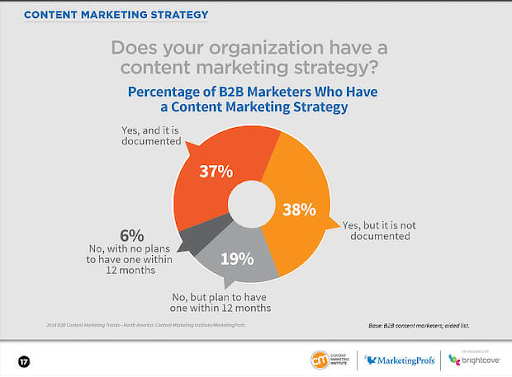
So how do you create a content marketing strategy that reaps rewards in 2022 and beyond?
Here’s how.
Step 1 – Identify your goals and audience persona
Ask yourself the following questions.
- Why do you want to use content? What do you want to achieve through it?
- What are your long term and short term goals?
- Who are you targeting?
- What problems of your target audience are you solving?
- Why would your potential consumers choose you over your competitors? What is your USP?
These are loaded questions and require comprehensive answers. But without answers to these questions, you can’t start creating a content marketing strategy.
Without a mission statement and SMART goals, you won’t be able to pinpoint the kind of the content you need to create, distribute and test.
Now, what are SMART goals?
SMART goals are,
- Specific
- Measurable
- Attainable
- Realistic
- Time bound
So instead of aiming for ‘more social media followers’, set your goal ‘double social media following by the end of Q1 by using paid ads’. It is specific, measurable, attainable, realistic, and time bound!
Another example of a SMART goal is ‘increase web traffic by 10% by the end of Q2 through publishing and promoting 4 blog posts each month.’
Step 2 – Establish KPIs
The next step is to outline the KPIs you’d like to track. They’re closely related to your marketing goals, which is why it’s best to establish them before outlining content assets.
Some KPIs you can measure,
- Unique page visits – What’s the first thing everyone tracks? Website traffic. Unique page visits tell you how many new people are visiting your website every day, every week, or every month.
- Downloads: Added a content upgrade to your content or a form to your landing page? Download tells you how many people are downloading your content.
- Time on page: Yes you’re getting a healthy amount of website traffic, but how long are users staying on your website? That’s a more important question.
- Inbound links: How many people are linking out to your content?
- Comments and engagement: Are people interacting with your content? Are they commenting on your blog posts and sharing them?
- Cost per click: If you’re investing in paid advertisement, what’s your cost per click?
- Cost per lead: And likewise, what’s your cost per lead?
- Conversion rates: Are your leads converting? If not, why not? And if yes, what’s the conversion percentage? Keeping a close eye on this metric helps to optimize campaigns that are showing results and end those that aren’t.
Step 3 – Understand your audience
Once you’ve established your goals and outlined the KPIs you’d like to track, it’s time to determine who your target audience is. Where are they hanging out in the digital sphere? What are their problems? What solutions are they seeking? What are their demographics, work details, interests?
The more comprehensive your audience persona, the better it will help you in creating an optimum content marketing strategy.
How to conduct audience research?
- Use social listening and monitoring tools to keep an eye on what your target audience is talking about online. Not only what they’re saying about your brand, but what they like discussing in general (related to your industry)
- Customer surveys, especially when attached to some sort of incentive, work great as audience research tools. Ask specific but succinct questions in those surveys and offer an incentive that encourages your target audience to answer. You can share these surveys on social media, via your blog, or just email them to your current email list. The more answers you get (from your target audience) the more it will help in creating an audience persona.
- Use Google Analytics and social media analytics to pinpoint the demographic details of your audience. Where do they reside? What age group are they from? And so on.
Step 4 – Run a content audit
Semrush defines content audit as, “the process of systematically analyzing and assessing all the content on your website.”
Where is your content marketing strategy at right now? What content marketing tactics have you employed for your business? And what results are they showing?
Running a content audit will determine your highest performing and lowest performing content assets. This will help you determine if your marketing goals are being met with the current content assets and if not, what changes do you need to make in your strategy.
How to conduct a content audit?
- Start off with outlining your goals? What are your current content marketing goals? And what KPIs are you looking to track?
- Next, take an inventory of your current content. What content assets have you invested in uptil now?
- Analyze the data. This one’s a little complicated. Use one of the many tools available online, like HubSpot, Semrush, Moz, to analyze your data.
- Assess what content assets you’d like to keep and which ones you’d like to discard. A lot of content may need to be optimized to further improve performance too.
Routinely conducting a content audit is a great way of optimizing your content strategy. This is also where you’ll assess your current content position. Where is your content in terms of SEO? What are some content gaps you need to fill? How does your content compare to your competitors?
And lastly, how will new content fit with your existing content assets?
Step 5 – Decide on the content types you want to create
Now, we’re on to the fun part.
Different content types cater to different audiences at different levels of your marketing and sales funnel. Once you’ve outlined your audience and determined your goals, start brainstorming on the different content types you’d like to start.
It’s a two step process.
Step 1 – Figure out the platforms you want to distribute content on
Do you want your brand presence on social media – Instagram, Facebook, Twitter, YouTube, etc – or just your website? Do you want to send newsletters to your email subscribers?
Keeping your marketing goals in mind and outline the platforms you’d like to create content for and distribute on.
Step 2 – Decide on the content types you’d like to create
As discussed earlier, there are a plethora of different content types you can create for your business. From video to blog posts, there are different types of content you can experiment with.
Tip: Try experimenting with content atomization. Create larger pieces of content – a long form article or a long video – and break it down into different pieces of smaller content. Gary Vaynerchuck is a big believer in this practice. His team uses his longer talks and converts them into shorter, bite-sized content pieces for instagram, Twitter and Facebook. They also then take key points from that talk and turn it into a shorter blog post. It can then be further converted into an infographic, meme, GIF, or even a quote to post on social media.
So if you’re smart, you can easily turn one piece of content into multiple pieces of content.
Step 6 – Allocate resources accordingly
Now that you’ve decided on the types of content you’d like to create and the digital platforms you’d like to distribute them on, it’s time to start allocating resources accordingly.
Who’s going to create your content assets?
Will you hire a content agency, work with freelancers, or create them in-house?
Different content assets require different experts. Video requires video editors and professional video producers. Blog posts and website copy require content strategists and writers. Similarly, pictures, graphics, and infographics require graphic designers.
Once you outline the different types of content you’d like to create, you can then allocate marketing dollars to experts.
Next, you need to figure out what tools and softwares you’d like to invest in. From content management softwares and data analysis softwares, to video editors and graphic design softwares, there are several different types of tools that can streamline your workflow and help you create excellent content.
Step 7 – Create a content calendar
You know what content you’re going to create.
You know where you’re going to distribute it.
It’s time to create a content calendar.
According to Backlinko, “A content calendar (also known as an “editorial calendar”) is a written schedule of when and where you plan to publish upcoming content. Content calendars typically include upcoming pieces, status updates, planned promotional activity, partnerships, and updates to existing content.”
A content calendar makes sure all your content pieces are being uploaded at the right time. You can even schedule time-sensitive pieces well in advance. It helps you streamline your entire workflow. A content calendar can also help in collaboration. You can collaborate with content creators and your boss, making sure everyone’s on the same page.
Tools like Notion and Trello are great at helping you create collaborative content calendars.
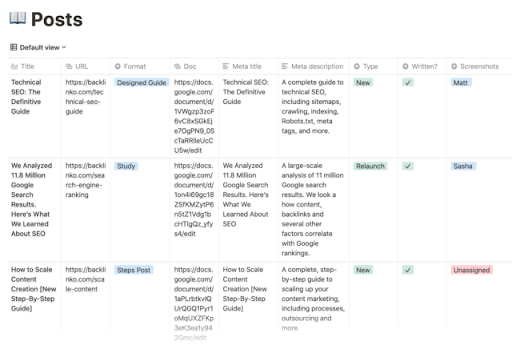
If you’d like to manually create a content calendar, Google Sheet and Microsoft Excel are great options.
Step 8 – Create and distribute your content
Now that you’ve done all the preparation, it’s time to start creating your content and distributing it. Communicate clear deadlines with your content teams. Create a media library. Determine your brand identity and brand colors.
All this will help in creating content that is cohesive and flows well together.
Once you’ve created your content, especially for one quarter, start adding them to the content library and distributing them.
Step 9 – Test, test, test
We’re finally on the final step – measuring the success (or failure) of your content marketing strategy. Without a proper A/B testing process in place, you will never know which content assets (and platforms) to work more on and which ones to discard.
Even if your content is likely getting engagement (which it probably is in the form of likes, shares, increase in followers, etc.), there’s still room for improvement. A/B testing allows you to test 2 or more versions of the same element to see which oné getting better results. It helps to optimize different elements of your content and ensure that you’re getting the highest amount of conversions possible.
Two elements that you absolutely need to A/B test are,
- Headline
Whether that’s your blog headlines, your paid advertisement headlines, or even headlines on your landing page, always test them. The variations don’t need to be wildly different from the original, even tweaking a few words here and there can make a huge difference in terms of conversions.
- Images
Visuals are a critical element of a blog post or landing page. So use images that not only appeal to your audience but also convey the right message. If you have a design team on board, they can help you come up with multiple variations of the same image and you can test them to see which one gets the best results.
This is also very important when running social campaigns and paid advertisements. A single picture can make or break your campaign, so A/B testing them is essential.
Wrapping up
Keep tracking your content marketing strategy progress and tweaking different elements of it to ensure it’s always performing optimally.
Sometimes I wonder if I really can. But then I think to myself, maybe I can’t. But if I could, that would be good. Maybe it’s all a lie? Cant wait to read more on your site.
The field of artificial intelligence (AI) research was founded as an academic discipline in 1956.
Our commitment is a seamless shopping and service booking experience for your customers. Choose MOM App for customer-centric solutions. 🌟 #CustomerExperience #MOMApp